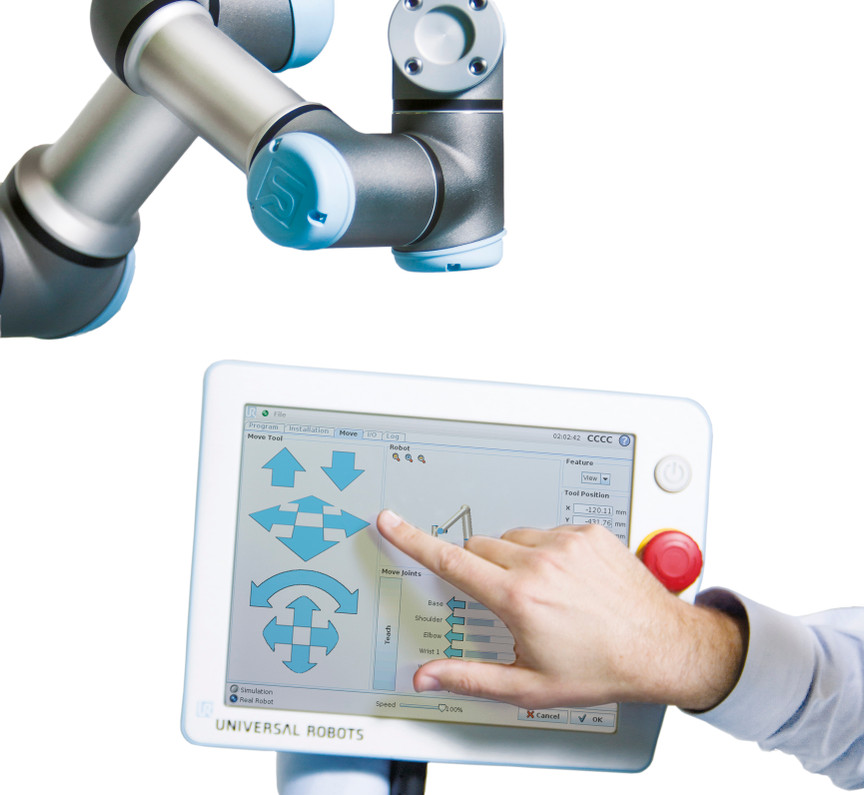Foundations of Building a Collaborative Robots Training Program
There are two ways to source in-house robotics experts: through recruitment or training. Even through recruitment, you may struggle to find applicants with the robotics training matching your exact application needs as there is currently a skills shortage in robotics. Training is likely to be part of every move to in-house expertise, even with new recruits.
An alternative to in-house robotics expertise is outsourcing. Contractors, or robot integrators, can design and install your robotics system. A good integrator will have knowledge of the technology and participate in a continuing education plan, however, new robotic solutions requiring little to no programming experience mean that this contractor may not be required.
Traditionally, having in-house robotic expertise was prohibitive in cost and complexity, especially for smaller businesses. Most previously installed automation solutions were considered permanent and many companies found that having a robotics expert on hand was not worth the investment. Integrators usually specialize in only a couple of areas, such as end-of-line packaging solutions, materials handling, or robot vision. In traditional automation scenarios, this specialization was highly valuable as it was unlikely that in-house training could ever match the skills of the robotics contractor. While automation technology has come a long way in recent years, these challenges are still present when addressing traditional industrial robots.
Collaborative robots eliminate some of these barriers to adopting a new automation process. They are easier to program and therefore easier to integrate. Cobots require a significantly lower investment than traditional robots, are very flexible and agile, and simple automation programs may be created by those with no robotic or programming experience. These factors alleviate the need for an in-house robotics expert.
By starting with more simple programs, gradually training employees to work with collaborative robots and build their knowledge base into creating more complex tasks is far less time consuming and less expensive. Collaborative robots tend to be deployed on smaller projects and since everyone, even traditional integrators are still learning about them, everyone is on a relatively level playing field when it comes to developing a level of expertise.
Robotic automation is no longer reserved for large, mass market manufacturers. In the past, an investment in robotics was steep, setup times were lengthy and the disruption caused by installing a new robotics system was extensive, not to mention the amount of space these systems required. In 2008, the robotics industry began to reconsider its traditional place in manufacturing. Universal Robots launched its first cobot, the UR5, around this time.
New cobot automation systems generally cost around $50k compared to a traditional system of $250K, however, the lower cost is perhaps not even the most attractive reason to look to cobots as a solution. The biggest advantage of collaborative robots is their flexibility and agility. They can be quickly repurposed from one task to another, so that leaves training as the final hurdle to adoption.
Yes, cobots are relatively easy to learn and program, but the question all companies must ask themselves is whether they want to train their workforce. With traditional robots, a third-party integrator was more economical and less of a hassle. Now that the collaborative robot option has become a reality for many facilities, in-house employees may be easily trained on basic collaborative robot skills. No special expertise is required.
Since comfort levels vary with the thought of employee robotics training, let’s compare the options on cost, flexibility, quality, control and convenience.
Cost – The Bottom Line
In-House: Training costs, extra personnel costs, lost work hours due to training, travel costs of off-site training
Outsourced: Work cost, travel costs for contractors, contract and legal costs, unpredictability associated with changes in scope of work and associated costs
Flexibility – Cobots Have the Advantage
In House: Easy to change robot application, chance for hands-on workforce to offer improvements to the process
Outsourced: Ability to change integrators when required, scalability and better reaction time, fixed-cost outsourcing may offer some financial flexbiltiy
Quality – Will the Robot Perform as Expected?
In House: Employees are vested in a collaboration with the robot and can drive quality improvements, quality control may be easier to manage in-house, employees can take full advantage of the cobot as they learn more about its capabilities
Outsourced: Deep knowledge of robotic technology, changes to robot application set-up can result in extra costs
Control – Internal knowledge equals more control
In-House: Control over integration, proprietary information I kept confidential, increase business stability by not being dependent on an external resource
Outsourced: An outside perspective and broader experience could lead to the development of a better robotics solution, loss of at least some control over how the job is executed, the reputation of the external company could impact the company’s business positively or negatively
Convenience: A Level Playing Field?
In House: No delays in re-deployment as may occur due to scheduling an external resource, internal employees understand process changes as they are happening and can take preemptive steps in robot integration
Outsourced: Does not require employee retraining for more advanced tasks, expanded knowledge base of contractors may allow for faster adoption of new technologies
Both in-house training and outsourced robotics expertise have their pros and cons. The introduction of collaborative robots with their low cost, ease of use, and flexibility give businesses more robotics management choices than traditional industrial automation systems.
Recent Posts
-
Ensuring Quality and Compliance: Zebra’s Machine Vision Solutions for Modern Packaging
In the highly regulated packaging industry, manufacturers must ensure product quality, labeling accu …Mar 6th 2025 -
Reduce Warehouse Injuries with Robotic Palletizing – Now Available for Just $2,500/Month
Loading and unloading pallets is one of the most physically demanding and injury-prone tasks in ware …Feb 28th 2025 -
The Competitive Edge: Why Machine Vision is Essential for Modern Manufacturing
Manufacturing is evolving rapidly, driven by increasing demands for precision, efficiency, and quali …Feb 20th 2025






